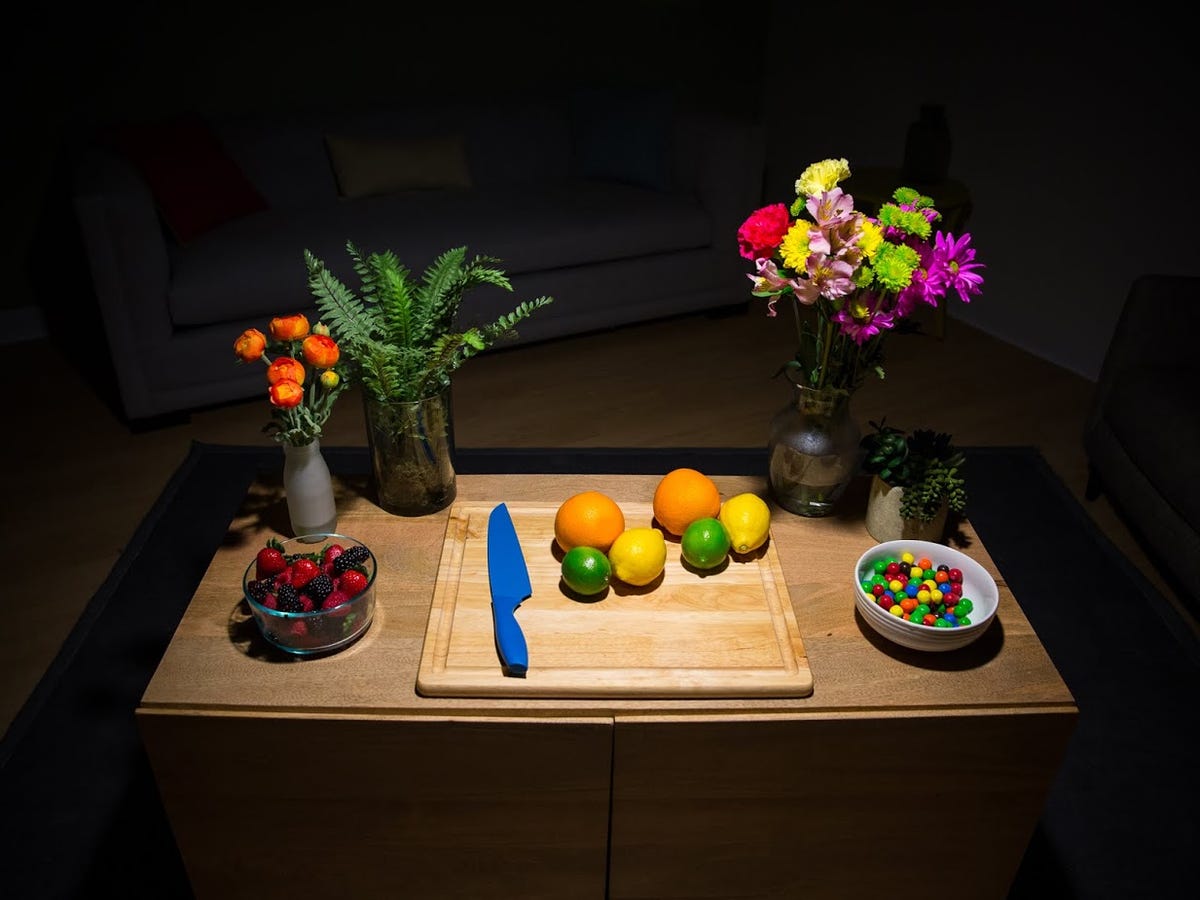Which LED floodlights offer the sharpest color quality? (pictures)
Looking for a light that'll produce bright, vivid colors in your home? We've got some handy comparison shots to help you pick the right one.

Which floodlights keep color tones true?
If you're on the hunt for new floodlights, then you'll want to consider LEDs, which offer high efficiency and long-term energy savings. But which ones are best for vivid, eye-popping color quality? Click through for a full comparison of five top contenders.
Philips EcoVantage BR30 Halogen
We'll start out by looking at the kind of baseline bulb you might be looking to replace -- a halogen floodlight from Philips.
Philips EcoVantage BR30 Halogen
Halogen lights are just incandescents with a little bit of non-toxic gas trapped with the filament for a slight boost in efficiency. As such, they offer color quality that's close to the high standard put out by incandescents.
Philips WarmGlow BR30 LED
The Philips WarmGlow BR30 LED is a floodlight that glows orange as you dim it down, for an interesting sunset-like effect. At full brightness, though, it's a yellowish 2,700K.
Philips WarmGlow BR30 LED
It might be a touch too yellow for some tastes. The colors don't look bad, and the white of the bowl looks about right, but compare the wood grain of the tabletop with slide 3. It's a pretty noticeable difference.
Philips SlimStyle BR30 LED
Next up is another option from Philips -- the flat-headed SlimStyle BR30 LED. This low-cost light offers a radically different design that eliminates the need for heat sinks.
Philips SlimStyle BR30 LED
As you can see, it does a pretty nice job with color quality, too. For the most part, everything looks "right," and the tabletop isn't quite as yellowed out as it was under the Philips WarmGlow.
Cree BR30 LED
Cree's 60W Replacement LED is one of our favorite values in the lighting aisle, and the company's TW Series bulbs offer exceptional color quality. So how does the Cree BR30 LED floodlight stack up?
Cree BR30 LED
As you can see, things look a lot more yellowed out than we saw with the SlimStyle -- the color quality is arguably worse than with the WarmGlow LED, too. It isn't terrible, and we're definitely nitpicking, but the difference is certainly noticeable.
GE BR30 LED
Next up is the standard BR30 LED from GE.
GE BR30 LED
Looks almost identical to what we saw with Cree. Not bad, but a bit too yellow.
GE Reveal BR30 LED
The GE Reveal BR30 LED promises a dramatic uptick in color quality, with a CRI score about 10 points higher than the other competitors we're looking at have.
GE Reveal BR30 LED
In our studio, that translated to pretty terrific color quality.
Philips EcoVantage BR30 Halogen
Let's take a closer look at that candy. Here's the halogen baseline bulb, with fairly well-rounded color quality.
Philips WarmGlow BR30 LED
And here's the Philips WarmGlow. Things look good, but tinted a bit orange.
Philips SlimStyle BR30 LED
The SlimStyle shows some orangeness, too, along with a more focused beam of light that makes the bowl look a bit brighter.
Cree BR30 LED
The Cree's floodlight washes things out in yellow light.
GE BR30 LED
GE's standard LED again looks pretty close to the Cree, but up close, I'd say it's a touch better. The white of the bowl is the giveaway.
GE Reveal BR30 LED
Finally, here's the GE Reveal. Again, among these five LEDs, it looks like the clear winner to me.
Philips EcoVantage BR30 Halogen
Time for our citrus test, which left me craving a margarita. Here's the Philips EcoVantage halogen floodlight. With an even color rendering score, everything looks just about right. Keep an eye on that orange on the left, though.
Philips WarmGlow BR30 LED
With the Philips WarmGlow LED, that orange looks a little bit lemony. That's because LEDs have a notoriously difficult time rendering red tones. Result, yellower oranges.
Philips SlimStyle BR30 LED
The SlimStyle yellows things out, too, though I'd say it's a touch better than the WarmGlow.
Cree BR30 LED
The Cree wasn't too bad in this test, either, which was a little surprising.
GE BR30 LED
The GE LED, on the other hand, took a step backward.
GE Reveal BR30 LED
The GE Reveal, however, nailed this test. The oranges look orange, the blue knife looks perfectly blue, the white cutting board looks white, and the skin tone on my hand looks more accurate than in the other shots.
Philips EcoVantage BR30 Halogen
Our last test is another fruit challenge -- a bowl of berries. Here's how the halogen floodlight did.
Philips WarmGlow BR30 LED
Here's the Philips WarmGlow LED...
Philips SlimStyle BR30 LED
...here's the Philips SlimStyle...
Cree BR30 LED
...the Cree BR30...
GE BR30 LED
...the standard GE BR30 LED...
GE Reveal BR30 LED
...and finally, the GE Reveal. Again, I'd say that it did the best job, making it a clear winner in our overall color quality tests.
Review your options
Of course, there's a lot more than color quality to consider when upgrading your lighting. Be sure to check out our reviews and our light bulb buying guide to help inform your buying decision.

